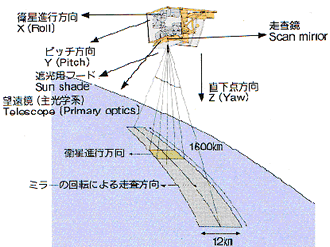 | Overall observations of the Earth atmosphere-surface system |
| GLI has many more visible and infrared channels than other ocean-color sensors, such as OCTS system (Midori) and land-observation sensors. This enable GLI to observe the total atmosphere-to-surface. It also has atmospheric correction channels necessary for high-precision observation of the ocean color and wide dynamic range channels for land and atmosphere observation. |
 | Overall observations of the Earth from local scale to global scale |
| GLI has six 250-m resolution channels for compatibility with Landsat / TM data and performs middle resolution observation of the Earth's global surface. These six 250-m channels together with 30 other 1-km resolution channels observe local-scale to global-scale phenomena. |
 | Estimations of new geophysical parameters |
| GLI has some important channels that had not been utilized, such as the near ultraviolet channel (0.38 micrometers), oxygen absorption channel (0.76 micrometers), and the water vapor absorption channel (1.4 micrometers). Aerosols on the ground surface, cloud geometrical thickness, and water vapor amount will be retrieved from these channels. |
 | More details, more accurately |
| GLI has 1.6, 2.2, 3.7, 8.6, 10.8, and 12.0 micrometer channels that correspond to atmospheric window domains. There are a few moderate resolution sensors such as MODIS that also have those channels. In addition, GLI has 6.7, 7.3 and 7.5 micrometer channels for acquiring the vertical profile of water vapor. It also has a tilting function necessary for ocean-color observation at middle and higher latitudes. |


